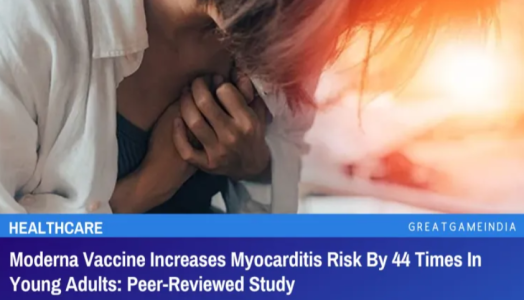According to a peer-reviewed study published in Nature Communications, the Moderna vaccine increases myocarditis risk in young adults by 44 times.
The risk of myocarditis jumps a week after vaccination for both the Pfizer and Moderna vaccines, according to a French peer-reviewed study (pdf below).
For BNT162b2 (Pfizer-BioNTech) and mRNA-1273 (Moderna), the risk of myocarditis after mRNA vaccination was 8 times and 30 times higher than that of the unvaccinated control groups, respectively.
For people between the ages of 18 and 24, there was a 44-times-higher risk of myocarditis following the Moderna vaccine.
Regarding the Pfizer shot, the risk was 13 times greater in comparison to the same age group.
Comparatively speaking, the probability of getting the same condition increased nine times after contracting the Chinese Communist Party virus.
Myocarditis is a potentially fatal condition that refers to the inflammation of the heart muscle. This heart disease has a variety of known causes. The most recent scientific findings indicate that viruses are the primary cause; nevertheless, during the pandemic, COVID mRNA vaccines have established themselves as a leading suspect for myocarditis.
The new study’s objective was to assess the relationship between vaccination and various sex and age groups.
“Both SARS-CoV2 infection and COVID mRNA vaccines have been associated with myocarditis. Knowing the spike protein’s affinity to ACE2 receptors in the heart and spike protein’s injury to cardiomyocytes (cells of the heart), the association of myocarditis with SARS-CoV2 virus or spike protein-based mRNA vaccination was not entirely unexpected,” said Dr. Sanjay Verma, a cardiologist.
Additionally, Verma believes that the CDC’s data “erroneously suggests” that the risk of myocarditis following SARS-CoV2 infection is higher than the risk after COVID-19 mRNA vaccine.
“For the cases of myocarditis after SARS-CoV2, CDC uses officially confirmed PCR+ ‘cases,’ even though their own seroprevalence data demonstrates that far more people have been infected than officially conformed PCR+ ‘cases.’ For example, seroprevalence data as of Feb 21, 2022, reveals 75 percent (about 54 million) of all children have been infected compared to 12 million officially confirmed PCR+ ‘cases’ (i.e., the actual number of kids infected is 4.5 times greater than PCR+ ‘cases’). Therefore, calculating the risk of myocarditis after SARS-CoV2 infection, the rate noted by CDC would therefore need to be reduced by 4.5 times. Thus far, CDC has not adjusted its COVID-19 morbidity and mortality data accordingly,” said the cardiologist, who practices in Coachella Valley, California.
In France, between May 12, 2021, and October 31, 2021, 46 million doses of an mRNA vaccine were administered to 32 million people, resulting in 1,612 cases of myocarditis and 1,613 cases of pericarditis.
It is limited since it only uses hospital discharge diagnoses. Therefore, it excludes patients who may have passed away before hospitalization or whose symptoms were not serious enough to cause hospitalization.
“There have been reports (pdf) of autopsy-proven myocarditis after vaccination and anecdotal evidence of patients being dismissed by ER and never being hospitalized. Adjusting for these excluded subsets may yield even higher risk than reported in this study. Follow-up of the patients in this study was limited to one month after discharge. However, a previous cardiac MRI study found about 75 percent of patients with vaccine-associated myocarditis can have persistent MRI abnormalities 3–8 months after initial diagnosis,” Verma said.
Since booster vaccination is not yet recommended for young adults in France, the study’s authors did not examine its effects.
However, regardless of age or prior illness, booster injections are required in the United States by colleges and universities, employers, and even certain state public health departments.
“In a preprint follow-up to their peer-reviewed study of myocarditis after vaccination, analysis found continued incremental risk of myocarditis after booster vaccination. In fact, while many countries have refrained from recommending COVID vaccination in very young children because the risks do not justify the benefits, the U.S. stands alone in recommending it in the youngest of kids,” Verma said.
The Omicron variant and its quick spread were “not a match” for Cornell University’s pandemic control measures, which included vaccine and mask mandates, isolation, and contact tracing, according to a study that was published on May 18. Cornell University was almost entirely immunized.
Sudden Adult Death Syndrome
Recently, the term “sudden adult death syndrome,” or SADS, has received media attention.
Undiagnosed myocarditis, inflammatory diseases, and other illnesses that disrupt the heart’s electrical system and result in cardiac arrest are among the underlying causes of SADS.
Between 1966 and 2004, there were 1,101 sudden deaths among athletes under the age of 35, giving a rate of 29, on average, for all sports, according to data published by the International Olympic Committee. Around the world, at least 769 athletes have experienced cardiac arrest, collapsed, or died on the field between March 2021 and March 2022 alone—a single year.

In 2021, sudden death among EU FIFA (soccer/football) athletes climbed by 420 percent. In the past, roughly five soccer players have died each year while playing in the game. Twenty-one FIFA players passed away unexpectedly between January and mid-November 2021.




